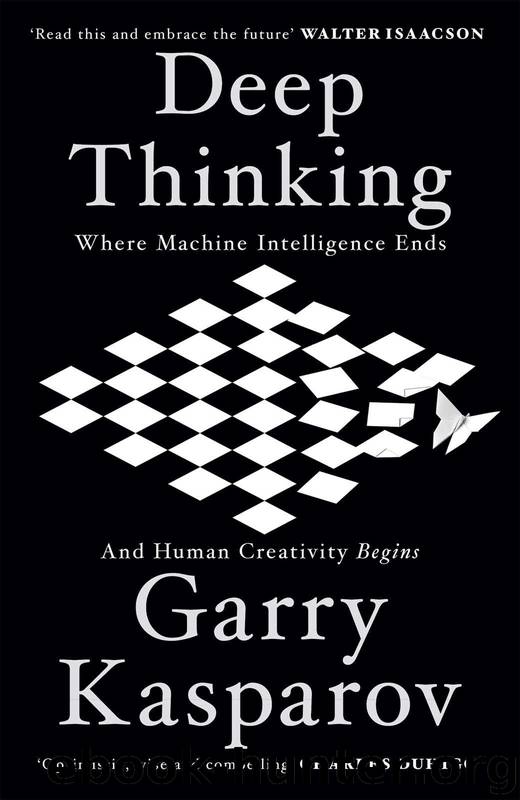Deep Thinking: Where Machine Intelligence Ends and Human Creativity Begins by Garry Kasparov

Author:Garry Kasparov [Kasparov, Garry]
Language: eng
Format: epub
Tags: Computers, Intelligence (AI) & Semantics, Cybernetics, Games & Activities, Chess, Social Science, Future Studies
ISBN: 9781610397865
Google: ffYZDQAAQBAJ
Amazon: 161039786X
Publisher: Hachette UK
Published: 2017-05-01T16:00:00+00:00
CHAPTER 8
DEEPER BLUE
KEN THOMPSON designed the revolutionary chess machine Belle, whose chips Deep Blue’s were based on, while working at Bell Laboratories in New Jersey, the famous “Idea Factory” that did pioneering work on breakthroughs in everything from solar cells and lasers to transistors and cell phones. Thompson was also the principal inventor of the ubiquitous Unix operating system while there, which is the basis for what runs Apple Macs, Google Android, and the billions of devices and servers running Linux.
As with the early years of ARPA, the concept at Bell Labs was to describe big problems and then work on creating the technology to solve them, instead of starting with a specific product in mind. I heard similar stories when I was invited to speak at General Electric’s new Innovation Center near Detroit in 2010. My hosts were eager to stimulate the sort of “blue sky” thinking that had gone out of fashion after decades of industry consolidation and acquisitions. During my seminar, someone pointed out that too often giant companies assume that even if they aren’t innovating, somebody is somewhere, and when something good comes along they will simply buy it. You can see how it eventually becomes a problem when everybody thinks somebody else will innovate.
I was reminded of this particular seminar in the context of chess machines because of a slide I used with a quote from Alan Perlis, a computer science pioneer and the first recipient of the Turing Award, in 1966, awarded by ACM. In a famous list of epigrams about programming that he published in 1982, Perlis wrote, “Optimization hinders evolution.” This jumped out at me because it at first sounds contradictory. How could making improvements in something prevent it from evolving? Isn’t evolution itself a type of steady improvement?
But evolution isn’t improvement; it’s change. Usually from simple to complex, but the key to it is increasing diversity, a shift in the nature of a thing. Optimization can make computer code faster but it won’t change its nature or create anything new. Perlis liked to show an “evolutionary tree” of programming languages, and how one led to another by evolving to fit needs and adapt to new hardware environments. He explained how ambitious goals are what lead to evolution because they create unexpected needs and new challenges that cannot be met only by optimizing existing tools and methods.
It’s also a matter of opportunity cost. If the focus is too heavily on optimizing, nothing new is created and stagnation can result. It can be too easy to concentrate only on making something better when we might be better served by making something new, something different.
Perlis’s adage can be applied broadly beyond programming, although care should be taken not to overdo it. It has itself evolved into the popular “optimization is the enemy of innovation,” which ropes in another slippery term. Many things we call innovations are little more than the skillful accumulation of many little optimizations. There wasn’t much new technology in the first iPhone, for example; it wasn’t even the first of its kind.
Download
This site does not store any files on its server. We only index and link to content provided by other sites. Please contact the content providers to delete copyright contents if any and email us, we'll remove relevant links or contents immediately.
Algorithms of the Intelligent Web by Haralambos Marmanis;Dmitry Babenko(16237)
Jquery UI in Action : Master the concepts Of Jquery UI: A Step By Step Approach by ANMOL GOYAL(9389)
Test-Driven Development with Java by Alan Mellor(7737)
Data Augmentation with Python by Duc Haba(7610)
Principles of Data Fabric by Sonia Mezzetta(7380)
Learn Blender Simulations the Right Way by Stephen Pearson(7296)
Microservices with Spring Boot 3 and Spring Cloud by Magnus Larsson(7139)
Hadoop in Practice by Alex Holmes(6589)
RPA Solution Architect's Handbook by Sachin Sahgal(6519)
The Infinite Retina by Robert Scoble Irena Cronin(6217)
Big Data Analysis with Python by Ivan Marin(5937)
Life 3.0: Being Human in the Age of Artificial Intelligence by Tegmark Max(5518)
Pretrain Vision and Large Language Models in Python by Emily Webber(4896)
Infrastructure as Code for Beginners by Russ McKendrick(4654)
Functional Programming in JavaScript by Mantyla Dan(4438)
WordPress Plugin Development Cookbook by Yannick Lefebvre(4386)
The Age of Surveillance Capitalism by Shoshana Zuboff(4250)
Embracing Microservices Design by Ovais Mehboob Ahmed Khan Nabil Siddiqui and Timothy Oleson(4149)
Applied Machine Learning for Healthcare and Life Sciences Using AWS by Ujjwal Ratan(4136)
